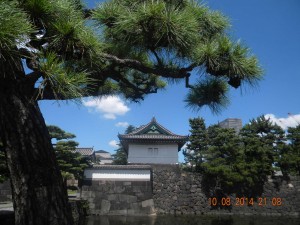 From Tokyo Station (Marunonchi Central Exit) is 15 minutes’ walk to the Tokyo Imperial Palace, this is our excursion with our knowledgeable tourist guide Larisa. I, personally, was not tired to be surprised how quickly she adapted to the metro system of such megapolis as Tokyo: transfer here and there and here we are in the center of Tokyo, near the Tokyo Imperial Palace. We are walking along the Nijnbash Bridge which is part of Tokyo Imperial Palace East Garden and belonged to the Edo Castle grounds.
From Tokyo Station (Marunonchi Central Exit) is 15 minutes’ walk to the Tokyo Imperial Palace, this is our excursion with our knowledgeable tourist guide Larisa. I, personally, was not tired to be surprised how quickly she adapted to the metro system of such megapolis as Tokyo: transfer here and there and here we are in the center of Tokyo, near the Tokyo Imperial Palace. We are walking along the Nijnbash Bridge which is part of Tokyo Imperial Palace East Garden and belonged to the Edo Castle grounds.
Although it is hard to believe, Tokyo, or Edo as it was known at the time, was a minor fishing village for much of its early history. It only came to national prominence when Tokugawa Ieyasu made it his base and later his capital when he became shogun in 1603. By the 19-th century, Tokyo had become one of the biggest cities in the world. It has shown little sign of letting up since then.
Today, the once humble settlement is the world’s most densely populated metropolitan area, housing upwards of 35 million people. The core of most populous part of Tokyo – the area that was known as Tokyo City before its merger with the wider Tokyo prefecture (province) in 1943-is divided into 23 special wards, each governed as its own city.
We took pictures at the Bridge and neared to the Palace. It was interesting to watch the contrast of old building on the background of high rise buildings. The Palace, itself, known as Kokyo, which literally means the Imperial Residence, is the primary residence of the Emperor of Japan Akihito (125-th Emperor of the same family of Jimmu), Today some of Edo Castle’s moats, defensive walls,  gate houses and turrets still remain.
gate houses and turrets still remain.
During the night of May 25, 1945 most of the Meiji era wooden buildings, including the main hall, were destroyed during the bombing raid on Tokyo. The main hall, which was the largest building, had a traditional Japanese exteria with the roof having the same shape as Kyoto Imperial Palace. Tokyo Imperial Palace, Kyoden, which is used for formal functions, was built in 1968.
We asked the Guards from Tokyo Imperial Palace about the present Emperor and Empress and what was that they answered: 
“The Palace is open to public only two times a year, on the Birthday of Emperor -23-rd of December, and on celebration of New Year, the 2-nd of January. Lots of festivities are being planned on those and the other days..
In spring, the count of cherry blossom trees comes at around 1000, making the Ueno Park, which is located within the reach, one of Japan’s most evocative spots, the cherry blossom season was commemorated by celebrated poet Matsuo Basho.The Park is considered by many to be Japan’s premier spot for arts and culture. The Tokyo National Museum can be found here, as well as the National Museum of Western Art, housed in a building by Le Corbusier.
Ueno and Akibahara are two integral stops of any Tokyo itinerary and both representative of the city in their own special way. They exemplify the city’s uncanny knack of uniting polar opposites to create an enthralling whole. Oh, we loved our excursions in Tokyo.
To understand better the Japanese culture I put this link:
Gagaku: the Court Music of Japan (complete) with Dr. W.P.Malm’s Explanations